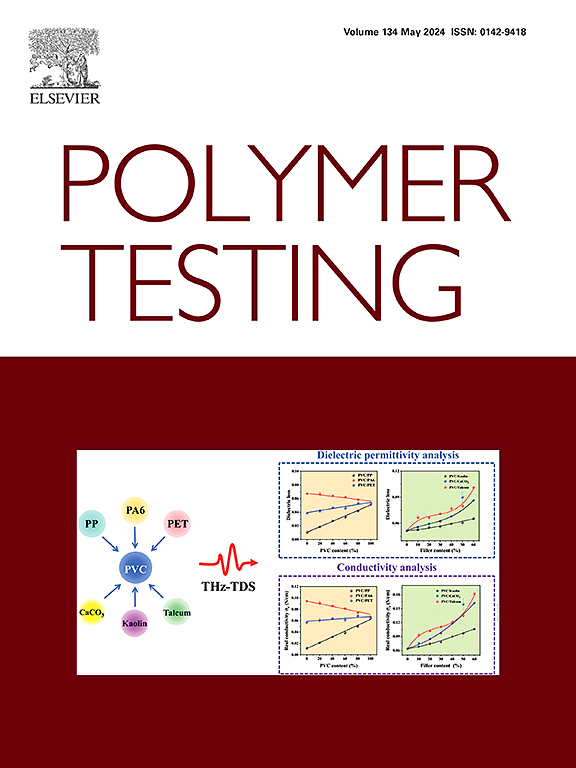Synergistic integration of porous polymer networks with solid-solid phase change material and surface-modified BN for enhanced thermal conductivity and latent heat storage
IF 6
2区 材料科学
Q1 MATERIALS SCIENCE, CHARACTERIZATION & TESTING
引用次数: 0
Abstract
Conventional phase change materials (PCMs) face two persistent challenges: low thermal conductivity and leakage during phase transitions. Studies have partially addressed these issues using porous carbon supports and core–shell encapsulation. However, these strategies often remain impractical for electronic thermal management applications due to their electrical conductivity or incompatibility with polymer matrices. Therefore, this study aims to develop a fundamentally new strategy that synergistically integrates a reinforced porous polyacrylamide–starch (PAM–S) framework, surface-functionalized agglomerated boron nitride (PA-ABN), and a Bi–Sn–In liquid metal alloy. The starch-modified PAM network enhanced structural integrity and inhibited filler sedimentation, facilitating a uniform filler distribution of the PA-ABN. Surface modification of ABN with polysilazane–silane improved polymer–filler interfacial adhesion and promoted the formation of a continuous, planar, through-plane thermal network, resulting in a higher thermal conductivity (3.34 W/m∙K) than the unmodified ABN composites. Similarly, the well-integrated filler network and reinforced porous framework significantly enhanced mechanical robustness, increasing tensile strength from 2.16 MPa (original PAM) to 14 MPa. The Bi–Sn–In alloy, characterized by high thermal conductivity and a low melting point (62 °C), infiltrated the polymer matrix–filler micropores, further reducing the interfacial thermal resistance. This design led to a composite with a latent heat capacity of 138 J/g and excellent leakage resistance up to 120 °C, maintaining stable thermal performance over 100 cycles and demonstrating superior CPU cooling efficiency compared to conventional thermal interface materials. These findings demonstrate a novel PCM composite architecture that simultaneously achieves leakage control, durability, and high heat-transfer efficiency, making it suitable for advanced thermal management applications.
多孔聚合物网络与固-固相变材料和表面改性BN的协同集成,以增强导热性和潜热储存
传统的相变材料(PCMs)面临着两个长期存在的挑战:低导热性和相变过程中的泄漏。研究已经部分解决了这些问题,使用多孔碳支撑和核壳封装。然而,由于其导电性或与聚合物基体不相容,这些策略通常在电子热管理应用中仍然不切实际。因此,本研究旨在开发一种全新的策略,协同整合增强多孔聚丙烯酰胺-淀粉(PAM-S)框架、表面功能化凝聚氮化硼(PA-ABN)和Bi-Sn-In液态金属合金。淀粉修饰的PAM网络增强了结构完整性,抑制了填料沉降,促进了PA-ABN填料的均匀分布。用聚硅氮烷-硅烷对ABN进行表面改性,提高了聚合物-填料界面的附着力,促进了连续的、平面的、穿过平面的热网的形成,使ABN复合材料的导热系数(3.34 W/m∙K)高于未改性的ABN复合材料。同样,良好集成的填料网络和增强的多孔框架显著增强了机械坚固性,将抗拉强度从2.16 MPa(原始PAM)提高到14 MPa。Bi-Sn-In合金具有高导热性和低熔点(62℃)的特点,渗透到聚合物基质填料微孔中,进一步降低了界面热阻。这种设计使复合材料具有138 J/g的潜热容量和高达120°C的优异泄漏阻力,在100次循环中保持稳定的热性能,与传统的热界面材料相比,显示出优越的CPU冷却效率。这些发现展示了一种新颖的PCM复合结构,同时实现了泄漏控制、耐用性和高传热效率,使其适用于先进的热管理应用。
本文章由计算机程序翻译,如有差异,请以英文原文为准。
求助全文
约1分钟内获得全文
求助全文
来源期刊

Polymer Testing
工程技术-材料科学:表征与测试
CiteScore
10.70
自引率
5.90%
发文量
328
审稿时长
44 days
期刊介绍:
Polymer Testing focuses on the testing, analysis and characterization of polymer materials, including both synthetic and natural or biobased polymers. Novel testing methods and the testing of novel polymeric materials in bulk, solution and dispersion is covered. In addition, we welcome the submission of the testing of polymeric materials for a wide range of applications and industrial products as well as nanoscale characterization.
The scope includes but is not limited to the following main topics:
Novel testing methods and Chemical analysis
• mechanical, thermal, electrical, chemical, imaging, spectroscopy, scattering and rheology
Physical properties and behaviour of novel polymer systems
• nanoscale properties, morphology, transport properties
Degradation and recycling of polymeric materials when combined with novel testing or characterization methods
• degradation, biodegradation, ageing and fire retardancy
Modelling and Simulation work will be only considered when it is linked to new or previously published experimental results.
 求助内容:
求助内容: 应助结果提醒方式:
应助结果提醒方式:


